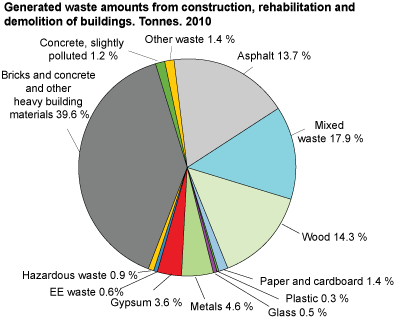Content
Published:
This is an archived release.
1.54 million tonnes of waste from building activities
In 2010, 1.54 million tonnes of waste was generated by new constructions, rehabilitation and demolition activities1 in Norway. Heavy building materials; mainly bricks and concrete, constituted about 40 per cent of the total waste generated. Mixed waste constituted 18 per cent, and asphalt and wood waste each made up 14 per cent of the total waste generated.
Waste from new constructions, rehabilitation and demolition of buildings constitutes about 18 per cent of the total waste generated annually in Norway. The vast majority of the waste contains materials that are relatively uncontaminated and which can be disposed of at landfills or reused without special environmental considerations. Some building materials do however contain hazardous substances, which must be properly treated.
Nearly equal amounts of waste from new constructions, rehabilitation and demolition
Thirty-five per cent (0.54 million tonnes) of the total waste generated from building activities in 2010 came from rehabilitation activities. Construction activities generated 34 per cent (0.52 millions tonnes), and demolition generated the last 31 per cent (0.48 million tonnes). Heavy building materials; mainly bricks and concrete, constituted about 40 per cent of the total waste. This includes 18 000 tonnes of slightly polluted concrete and bricks. The amount of hazardous waste was slightly more than 14 000 tonnes.
There is a relatively small amount of glass in the sorted waste fractions, and it is therefore assumed that a large amount of glass ends up in the mixed waste.
75 per cent of waste generated from demolition was sent directly to reuse or recovery
This statistic is based on information on waste generation and sorting from reports that are sent to the local authorities as a part of the building application system. Based on the reports collected in this survey, it is estimated that the share of mixed waste from new constructions, rehabilitation and demolition was 33, 22 and 6 per cent respectively. About 75 per cent of the waste from demolition activities (mainly concrete, metal and asphalt) was sent directly to reuse or recovery. This is an improvement since the survey in 2004, when it was estimated that 40 per cent of the waste went to unknown treatment.
The authorities’ focus on waste generated from building activities has led to changes in regulations that require at least 60 per cent of the waste to be sorted at the building site and a waste plan and final report to be drawn up and sent to the local authority. The survey indicates that the new regulations have affected the waste handling activities. Nevertheless, it is important to underline that the collected reports cover a small part of the generated waste, and there are therefore uncertainties related to how large a share of the waste is treated according to the regulations.
|
The regulation concerning waste reports covers waste from building activities and construction works, such as roads, bridges etc. This survey covers building activities only. The amount of hazardous waste is estimated from two sources. The data reported in waste reports and the declaration database (NorBas) covering ideally all hazardous waste handed in for approved treatment in Norway. |
The Waste Directive (valid in Norway due to the EEA agreement) includes a target of 70 per cent material recovery for non-hazardous waste from construction and demolition by 2020. It can be assumed that the sorted waste materials like metal, paper and plastics are sent to material recovery, whilst the wooden waste is most probably used for energy recovery. Waste used for backfilling operations is included in the target for material recovery.
Uncertainties remain in the figures
The quality of the data used as a basis for the statistics is improving. The greatest uncertainty is attributed to the demolition of buildings due to the low quality of data for the area. In 2004, the estimations were based on waste factors developed from waste reports from building projects in Oslo municipality. In this survey, data from several municipalities are used in addition to Oslo, and there is therefore a broader sample with respect to small and large cities and urban and rural districts. The collected reports cover some 4 per cent of the total waste generated.
| 1 | Building activities are defined as construction, rehabilitation and demolition of buildings regardless of who is carrying out the activities. Unregistered rehabilitation on a private basis is, however, not included in the statistics. |
Tables:
Contact
-
Manju Chaudhary
E-mail: manju.chaudhary@ssb.no
tel.: (+47) 99 58 02 06
-
Camilla Skjerpen
E-mail: camilla.skjerpen@ssb.no
tel.: (+47) 48 22 72 14

